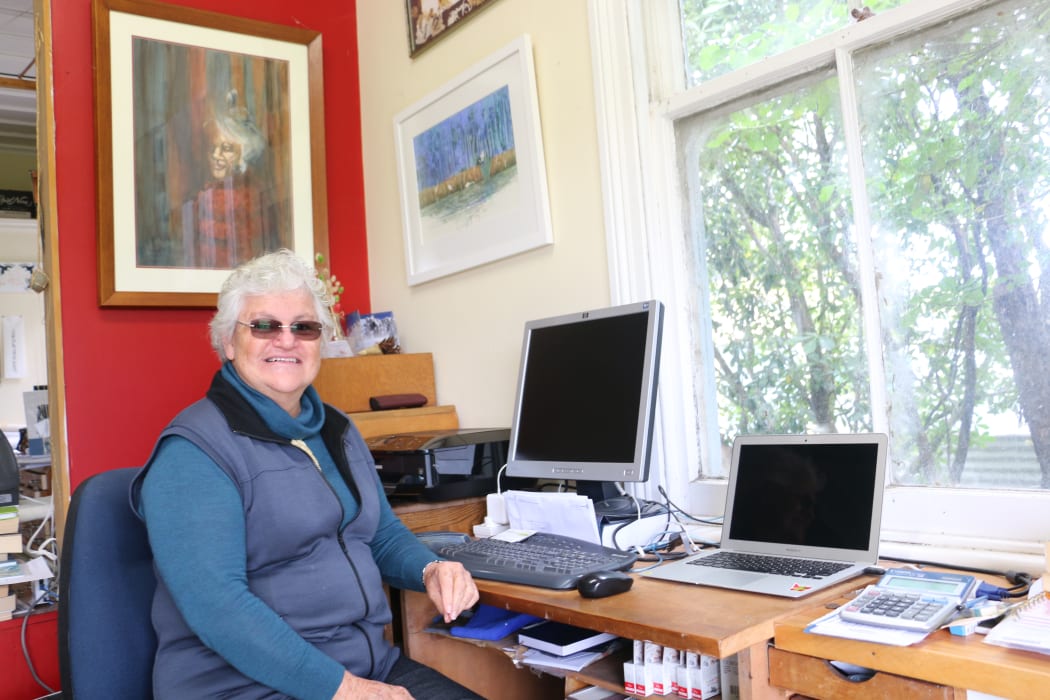
Dr Mere Whaanga, No Ngāti Kahungunu, Ngati Rongomaiwahine, Ngāti Pāhauwera. Photo: RNZ/Justine Murray
Mahia Beach is one of those typical country towns where it’s peaceful and quiet until the summer months bring outsiders, beach holidaymakers and more noise.
Dr Mere Whaanga’s house is right next to an urupa, on the odd occasion she has growled at people for taking food onto the tapu grounds, a few months ago she gave a stern growling to a man and a few months later he turned up at her front door with a bag of kina’s to apologise, Mere Whaanga recalls the event with a grin.
While Mahia offers the idyllic backdrop with the beach just metres away from her doorstep, Mere has spent most of her childhood and younger years inland at Paparatu in Gisborne, it is the site of the prophet Te Kooti’s first battle on 20 July 1868, but a major slip on the Mangapoike river caused a landslide on part of the battle site, Te Taiaha o te Kakari. During a visit in August she saw that while the landslip took out a part of the site, the land at the waahi tapu still remains.
As a child she enjoyed writing stories and poetry, she was in a class of 9 pupils and grew to just 21, all were farmer’s kids. John Templar was a former teacher of hers and had kept one of her writing exercise books from 1964 when she was twelve years old, around 2009 during a planned visit to Marton, he turned out to be the school’s principal and gave it back to her.
“He’d kept a portfolio of my writing all those years and he gave it back to me signed, and he said I need to tell you I’ve used this as a teaching resource all these years” she recalls.

Dr Whaanga standing in front of one of the round boulders called ‘He Taro a Kea’. The story of these boulders will be given in Chapter 2 Ancestral marks upon the land at Taipōrutu. Photo: Erika Schollum (2018)
A self-confessed bookworm, it was her father that encouraged her to write in Te reo Māori, today her books are published in both English and Te reo Māori, which she says continues to be a controversial matter. Mere spent years as a Sheep and Beef farmer alongside her late husband, and raised their three children in the country. A move to Taiporutu was imminent after her family gifted her land shares at Mahia.
“The aunts, when they gave me their shares they asked me to keep that name…it’s an old name, my dad explained as Tai being the sea, and porutu the sound it makes when it hits the rocks, that’s most noticeable when there’s a swell.” she says.
In 1986 that Mere made a conscious effort to start writing down the stories as told to her by her father which inspired her to write The Legend of the Seven Whales of Ngai Tahu Matawhaiti. Mere also illustrates her children’s books.
Dr Whaanga is this year’s recipient and the first Māori writer to be awarded the prestigious Michael Kings Writers Fellowship, the Children’s author, writer and academic will spend the next two years working on her next body of work centred on her tribal lands.

Dr Mere Whaanga will spend the next two years working on her book, Rongoā Heal The Land, Heal The People. Photo: RNZ/Justine Murray
The book, Rongoā Heal the Land, Heal the People was inspired by leading Rongoā practitioner Pa Ropata McGowan whose philosophy was that people need to heal the land before they can heal themselves, the book will explore the vital roles of plants in the settlement of Taipōrutu.
In addition to the research of the plants and geological sites, Dr Whaanga will draw on historical records, maps, photos and traditional accounts of the area passed down by her kaumatua (elders) that will feature in her book.
Kupu Māori
Urupa - Burial plot
Kina's - Sea Urchins
Rongoā - Medicinal native plants

